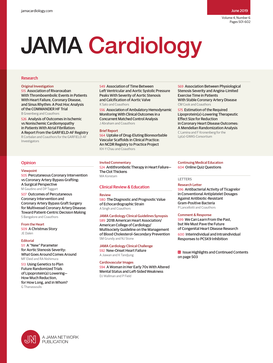钠-葡萄糖共转运蛋白2抑制剂在美国非卧床心血管护理心力衰竭中的应用
IF 14.1
1区 医学
Q1 CARDIAC & CARDIOVASCULAR SYSTEMS
引用次数: 0
摘要
钠-葡萄糖共转运蛋白2抑制剂(SGLT2i)治疗可降低心衰(HF)事件和心衰患者心血管死亡的风险。SGLT2i在美国心血管门诊护理中的使用趋势尚不清楚。目的评价心衰患者心血管门诊使用SGLT2i的比例。设计、环境和参与者这是一项从2019年7月1日至2023年6月30日进行的回顾性队列研究。纳入分析的是在国家心血管数据登记处(NCDR)实践创新和临床卓越登记处(PINNACLE)登记的心衰患者,这是一个国家门诊心血管护理质量改善登记处。研究数据分析时间为2024年2月15日至2025年1月15日。主要结果和测量:SGLT2i治疗的患者水平和实践水平处方。结果759例 915例患者(平均[SD]年龄70岁;359 270名女性[47.3%];49 黑人252人[14.6%];278名 303名白人[82.7%])在美国191个地点患有HF, 76名 927名(10.1%)服用SGLT2i。在可获得射血分数(EF)数据的患者中,20 544例(17.9%)HF合并EF降低(HFrEF)和36 615例(8.9%)HF合并EF轻度降低(HFmrEF)或HF合并EF保留(HFpEF)的患者开了SGLT2i。所有HF患者的SGLT2i使用率从2019年第三季度的4.6%增加到2023年第二季度的16.2%,HFrEF患者的使用率从5.1%增加到28.5%,HFmrEF或HFpEF患者的使用率从4.5%增加到12.8% (P < 0.001)。SGLT2i较少用于老年人(IQR年龄,80岁vs 63岁;或者,0.76;95% CI, 0.75-0.77),女性(OR, 0.79;95% CI, 0.77-0.81)和较高的收缩压(OR, 0.78;95% CI, 0.77-0.79),而2型糖尿病史与明显较高的使用相关(OR, 3.21;95% ci, 3.15-3.28)。在调整了患者和实践水平的特征后,SGLT2i在不同地点的使用存在显著差异(第90百分位vs第10百分位风险实践,调整OR, 4.40;95% ci, 3.76-5.52)。结论和相关性尽管本研究发现,在研究期间,非卧床HF患者中SGLT2i的使用有所增加,但大多数符合条件的患者并未接受这种治疗。年龄较大、女性和较高的血压与SGLT2i的较低使用相关,在不同的实践中使用存在显著的无法解释的差异。系统地努力改善SGLT2i治疗的使用是必要的。本文章由计算机程序翻译,如有差异,请以英文原文为准。
Sodium-Glucose Cotransporter 2 Inhibitor Use for Heart Failure in US Ambulatory Cardiovascular Care.
Importance
Sodium-glucose cotransporter 2 inhibitor (SGLT2i) therapy reduces risk of heart failure (HF) events and cardiovascular death among individuals with HF. Trends of SGLT2i use in cardiovascular ambulatory care in the US remain unknown.
Objective
To evaluate the rate of SGLT2i use among patients with HF in the cardiovascular ambulatory care setting.
Design, Setting, and Participants
This was a retrospective cohort study conducted from July 1, 2019, through June 30, 2023. Included for analysis were patients with HF enrolled in the National Cardiovascular Data Registry (NCDR) Practice Innovation and Clinical Excellence (PINNACLE) registry, a national ambulatory cardiovascular care quality improvement registry. Study data were analyzed from February 15, 2024, through January 15, 2025.
Main Outcomes and Measures
Patient-level and practice-level prescription of SGLT2i therapy.
Results
Of 759 915 patients (mean [SD] age, 70 [14] years; 359 270 women [47.3%]; 49 252 Black individuals [14.6%]; 278 303 White individuals [82.7%]) with HF at 191 US sites, 76 927 (10.1%) were prescribed SGLT2i. Among patients with available ejection fraction (EF) data, 20 544 (17.9%) with HF with reduced EF (HFrEF) and 36 615 (8.9%) with HF with mildly reduced EF (HFmrEF) or HF with preserved EF (HFpEF) were prescribed SGLT2i. Rates of SGLT2i use for all patients with HF increased from 4.6% in the third quarter of 2019 to 16.2% in the second quarter of 2023, from 5.1% to 28.5% for those with HFrEF, and from 4.5% to 12.8% for those with HFmrEF or HFpEF (P for trend <.001). SGLT2i was less commonly used for older persons (IQR age, 80 years vs 63 years; OR, 0.76; 95% CI, 0.75-0.77), female sex (OR, 0.79; 95% CI, 0.77-0.81), and higher systolic blood pressure (OR, 0.78; 95% CI, 0.77-0.79), whereas history of type 2 diabetes was associated with markedly higher use (OR, 3.21; 95% CI, 3.15-3.28). After adjustment for patient- and practice-level characteristics, significant variation in SGLT2i use across sites was present (90th vs 10th percentile risk practice, adjusted OR, 4.40; 95% CI, 3.76-5.52).
Conclusions and Relevance
Although this study found that SGLT2i use had increased among ambulatory patients with HF during the study period, the majority of eligible patients did not receive this therapy. Older age, female sex, and higher blood pressures were associated with lower SGLT2i use with significant unexplained variation in use across practices. Systematic efforts to improve SGLT2i therapy use are warranted.
求助全文
通过发布文献求助,成功后即可免费获取论文全文。
去求助
来源期刊

JAMA cardiology
Medicine-Cardiology and Cardiovascular Medicine
CiteScore
45.80
自引率
1.70%
发文量
264
期刊介绍:
JAMA Cardiology, an international peer-reviewed journal, serves as the premier publication for clinical investigators, clinicians, and trainees in cardiovascular medicine worldwide. As a member of the JAMA Network, it aligns with a consortium of peer-reviewed general medical and specialty publications.
Published online weekly, every Wednesday, and in 12 print/online issues annually, JAMA Cardiology attracts over 4.3 million annual article views and downloads. Research articles become freely accessible online 12 months post-publication without any author fees. Moreover, the online version is readily accessible to institutions in developing countries through the World Health Organization's HINARI program.
Positioned at the intersection of clinical investigation, actionable clinical science, and clinical practice, JAMA Cardiology prioritizes traditional and evolving cardiovascular medicine, alongside evidence-based health policy. It places particular emphasis on health equity, especially when grounded in original science, as a top editorial priority.
 求助内容:
求助内容: 应助结果提醒方式:
应助结果提醒方式:


